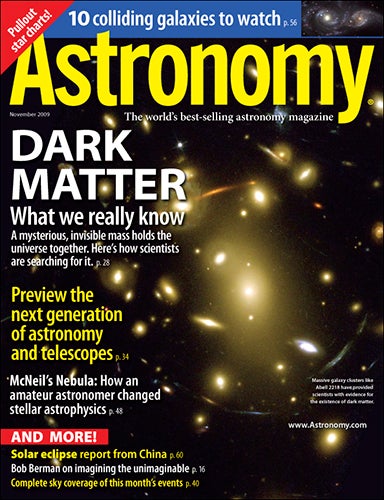
Editor David J. Eicher gives a video tour of the November 2009 issue
WAUKESHA, Wis. — The universe doesn’t abide by “what you see is what you get.” In fact, stars, gas, and dust account for only 10 percent of the universe’s mass. The other 90 percent is “dark matter,” and it likely surrounds almost every galaxy in the universe. This stuff is invisible, so understanding its characteristics remains a great challenge for astronomers.
In “What do we really know about dark matter?” Astronomy Associate Editor Liz Kruesi explains what scientists have deemed the potential candidates for dark matter particles, such as weakly interacting massive particles (WIMPs) and axions, and explores how astronomers are actively trying to detect them.
“One would expect that with so many [cold dark matter] particles, WIMPS or axions would be easy to find,” Kruesi says. “But because they don’t interact through the electromagnetic force, detecting them pushes scientists’ experimental limits.”
Related video: Cosmology 101: Dark matter
To read more about WIMPs and axions, and the methods used to detect them, pick up the November issue of Astronomy, on newsstands October 6.
“How an amateur astronomer changed stellar astrophysics”
In January 2004, Jay McNeil came across something unusual while imaging reflection nebula M78 — what turned out to be a bright cone of gas and dust illuminated by a young sun at the cone’s apex. The same star glowed faintly in the past, and astronomers knew such a flaring was a rare chance to study this critical phase in the evolution of a natal star. “How an amateur astronomer changed stellar astrophysics,” by Adam Frank, explains how research around McNeil’s Nebula helps scientists uncover what feeds these X-ray outbursts from young stars.
“Watch as galaxies collide”
Despite the vast distances between them, many galaxies twist and distort each other into weird shapes. These mergers can make for breathtaking photography and interesting visual observations. In “Watch as galaxies collide,” Astronomy contributing writer Alan Goldstein picks out 10 extragalactic train wrecks to target in our night sky — from near misses to full on impacts.
November night-sky events visible without optical aid
- November 1 — Venus passes north of the bright star Spica in the evening sky.
- November 17 — The Leonid meteor shower peaks.
Also in the November 2009 Astronomy
- “Astronomy: The next generation” — Beyond 2020, telescopes will be huge, cost-effective, and easy to service — even the ones in space.
- “Totality over China” — Traveling through China to witness a solar eclipse proved almost as exciting as the eclipse itself.
- “The Sky This Month” — Exclusive pullout star charts will guide you through November’s night sky.
- The November issue of Astronomy also includes Astro News, Beautiful Universe, Bob Berman’s Strange Universe, Glenn Chaple’s Observing Basics, David Levy’s Evening Stars, Stephen James O’Meara’s Secret Sky, Ask Astro, Astro Confidential, Deep-sky Showcase, Telescope Insider, New Products, and Reader Gallery.









